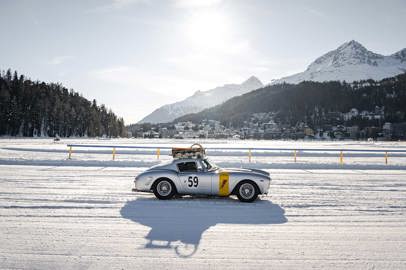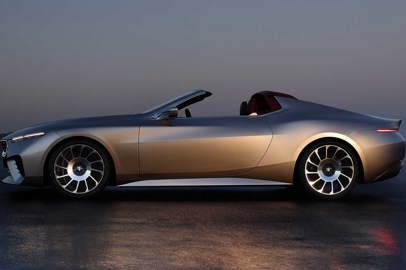07 May 2019
New 911 Speedster goes into production - 510 PS and limited edition
Pure Porsche: open-top two-seater for unfiltered driving experiences
The 911 Speedster already caused a sensation when it was presented as a concept vehicle. Now Porsche is putting the open-top two seater into production. The 911 Speedster combines the aspiration of a puristic, driver-oriented vehicle with motor sports technology suitable for everyday use. The 911 R (2016) and 911 GT3 served as a basis for development. A high-revving 375 kW (510 PS) four-litre naturally aspi-rated boxer engine delivers an emotive sound experience in the cockpit. The six-speed GT transmission is shifted manually. Visually, the new Speedster establishes a bridge to its own history – to the forebear of all Porsche sports cars, the 356 “No. 1” Roadster from 1948. The limited edition of the new 911 Speedster is also reminiscent of this vehicle. Exactly 1,948 units will be manufactured from mid-2019 at the Porsche plant in Zuffenhausen, Germany.

The 911 Speedster and the 356 “No. 1” Roadster from 1948 - © Protected by copyright and License Porsche
As a concept vehicle, the 911 Speedster celebrated its world premiere in 2018 at the ceremony for the “70 Years of Porsche Sports Cars” anniversary in Zuffenhausen. Other public appearances followed at the Goodwood Festival of Speed, the Rennsport Reunion VI in Laguna Seca, California as well as the Paris Motor Show in October. Numerous Speedster elements that characterise the concept vehicle can now be found in the same or similar design on the series production model.
Taking centre stage is the aesthetically shaped convertible top compartment lid with its double-bubble streamliners – a quintessential feature of this sports car type ever since the 911 Speedster from 1988. It is the largest and most complex component to date that Porsche has used in a road model made of a single piece of carbon-fibre reinforced plastic. Two trim elements in the double bubbles make room for the roll-over protection system as need, included in the two-seater as a standard feature just like in the 911 Carrera Cabriolet.

911 Speedster - © Protected by copyright and License Porsche
A weight-saving roof structure replaces the basic tonneau cover of the concept vehicle. Despite its puristic design, the fabric convertible top is suitable for everyday use. To-gether with the shortened window frames with their lowered cowl top panels and the smaller side windows, it gives the 911 Speedster its athletic profile. The excitingly low fly line already characterised historic designs such as the Porsche 356 Speedster from 1954.
The convertible top takes no effort to operate: the central locking hook at the wind-screen frame and both the side fins of the fabric roof are released at the push of a button. The large rear lid made from lightweight carbon fibre is electrically unlocked and slides back a short distance, is then positioned by hand and makes room for the fabric roof, which folds into a Z shape behind the front seats. The cover can then be closed again effortlessly once the roof has folded into position. The roof is closed again in the same way – only the roof fins on the left and right of the streamliners have to be pressed by hand into their holders until they perceptibly engage.

911 Speedster - © Protected by copyright and License Porsche
Rear spoiler and rear apron of the 911 GT3 Touring
Lightweight design also dictates other body components of the Speedster. The carbon-fibre composite bonnet – which weighs in two kilograms lighter than on the 911 GT3 – and the carbon-fibre composite wings are originate from the 911 R. The front apron was borrowed from the GT3, but the front spoiler lip is a completely new development. Instead of the Talbot mirrors used on the concept vehicle, the production version of the new Speedster features electrically adjustable and heated Sport Design exterior mir-rors. The extending, aerodynamically tuned rear spoiler and rear apron have been adopted from the 911 GT3 Touring for the Speedster.
The interior is characterised by black leather elements for the side bolsters and head restraints of the carbon-fibre composite full-bucket seats, the armrests in the door trims and the shortened gear lever. The centre panels of the seats are upholstered in perfo-rated leather, while the lightweight door panels with black door pulls and stowage nets reduce the overall weight.

911 Speedster - © Protected by copyright and License Porsche

911 Speedster - © Protected by copyright and License Porsche
“Speedster” logos adorn the head restraints and the visible carbon door sills as well as the central rev counter. Like the other instruments, it has black dials with white needles as well as green digits and scales – features reminiscent of its famous forebear, the Porsche 356 Speedster. A limited-edition badge on the cross structure behind the front seats shows the serial number of the 911 Speedster, which is limited to just 1,948 units. Porsche also optionally offers the new 911 Speedster with a Heritage Design package. Price in Germany: 21,634.20 Euro incl. VAT.
Created by Style Porsche and imple-mented by Porsche Exclusive Manufaktur, this equipment version reinterprets classic elements from the 1950s and 1960s. This includes the interior colour scheme in Black and Cognac with golden details. Special “spears” paintwork in White for the front fascia and front wings is applied to the basic vehicle paintwork in GT Silver Metallic. Historic looking motor sports decals for the doors and front lid complete the package. Owners can select their own maximum two-digit start numbers like shown in the photos. The Porsche crests and the gold-coloured logos correspond to the designs used in the 50s and 60s.
High-revving engine with 510 PS
The heart of the new Speedster is adopted from the 911 GT3. The naturally aspirated six-cylinder boxer engine with four-litre displacement is a pure GT engine. The peak power of 375 kW (510 PS) is reached at 8,400 rpm, with the maximum engine speed at 9,000 rpm. The engine delivers a maximum torque of 470 newton metres at 6,250 rpm. The new 911 Speedster accelerates from zero to 100 km/h in 4.0 seconds and reaches a top speed of 310 km/h.

911 Speedster - © Protected by copyright and License Porsche
Compared with the previous 911 GT3, the engine in the Speedster is fitted with two gasoline particulate filters (GPF) and complies with the emission standard Euro 6d TEMP EVAP-ISC (EU6 DG). However, the four-valve engine still manages ten PS more. This is due to improvements to detail such as the high-pressure fuel injectors with optimised spray pattern as well as a modified intake system with individual throttle valves, which enable a more spontaneous response to throttle commands. The newly developed lightweight stainless steel sports exhaust system weighs 10 kilograms less – including the two particulate filters.
Befitting its status as a driver’s car, Porsche only offers the 911 with a manual six-speed sports transmission. It features an auto-blip function which precisely and inde-pendently compensates differences in engine speed between the gears when down-shifting through automatic throttle blips. Auto-blip can be activated at any time, in other words also independently from the chosen PASM (Porsche Active Suspension Man-agement) variable damping system setting. A mechanical rear differential lock with asymmetric locking action rounds off sporty power transmission.

911 Speedster - © Protected by copyright and License Porsche
The GT philosophy behind the new Speedster is also reflected in its chassis. With its sporty rear-axle steering and dynamic engine mounts, the chassis is based on the technology of the 911 GT3 and 911 R. Control systems such as Porsche Torque Vec-toring (PTV), Porsche Stability Management (PSM) and PASM with sports tuning and lowering by 25 millimetres have been precisely adapted to the new requirements. The open-top two-seater runs on 20-inch forged Speedster alloy wheels with central locks. The standard equipment includes PCCB brakes (Porsche Ceramic Composite Brake) with internally vented and perforated ceramic composite brake discs. In Germany, prices for the 911 Speedster start at 269,274 euros including VAT and country-specific equipment. It can be ordered immediately.
Porsche Design Timepieces has also produced special chronographs for the new 911 Speedster, likewise limited in number to 1,948: the Porsche Design “911 Speedster chronograph” and the “911 Speedster Heritage Design chronograph” can be ordered exclusively by future owners of a new Speedster model at Porsche Centres around the world from May 2019. Price including VAT: 9,950 euros.

911 Speedster chronograph © Protected by copyright and License Porsche

911 Speedster Heritage Design chronograph © Protected by copyright and License Porsche
911 Speedster. Fuel consumption combined 13.8 l/100 km; CO2 emissions combined 317 g/km.
The consumption and CO2 emission values were determined in accordance with the new Worldwide Harmonised Light Vehicle Test Procedure (WLTP). The NEDC values derived from this should contin-ue to be specified for the time being. These values cannot be compared to the values determined in accordance with the NEDC measuring procedure used up to now. Further information on the official fuel consumption and official, specific CO2 emissions of new passen-ger cars is available in the “Guidelines on fuel consumption, CO2 emissions and power consumption of new passenger cars”, which are available free of charge from all sales outlets and from Deutsche Automobil Treuhand GmbH (DAT).
Edited by Lisa Maria River
Source and photos: Porsche
Photos protected by copyright and License: © Porsche.
Copyright © Sisterscom.com
Copyright © Sisterscom.com
You might be interested in
Lifestyle

Cars
The I.C.E. St. Moritz 2025: an edition to remember
Legendary classic cars and iconic sports cars in a unique atmosphere on the frozen lake of the Swiss Alps
Lifestyle

Cars
Jaguar Classic E-type Commemorative
The convertible celebrates the iconic sports car and marks 50 years since the end of production of the E-type in 1974. The exclusive collector's automotive jewel was made in only two pieces with handmade finishes. Jaguar Classic has teamed up with...
Lifestyle

Cars
BMW Skytop
A small-series model in a strictly limited edition ready to make the hearts of car enthusiasts and collectors beat faster






